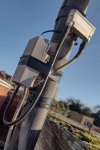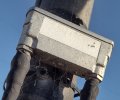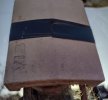We were discussing picture quality.
No we weren't. You were complaining about reception issues/breakup i.e. decodability, which is not the same thing.
Anyway, the filter you have installed is downstream of the amplifier and therefore not doing its job before the signal gets scrambled in the amp.
I guess you put it between the power supply and the amp. too, which means it's being cooked by the power supply.
How old is all that stuff on the mast? From the analogue days? And what are the two units? One's the amp. (probably with a huge amount of gain), but what's the other?
I would suggest you don't need any of it. If you do, can it be put inside (loft?) where you can a) get at it, and b) get the filter between the aerial and the amp/Humax? I would replace it all with a modern low-gain amp. (as discussed previously), but only then if needed. Try it without first.
Until you do, nothing will improve and you'll suffer from intermittent reception problems, as you've already demonstrated.
I wonder if you can get the Restoretv people to send someone to sort this, otherwise I think you'll have to get someone in yourself.
And it's all oh-so-lovely with that tape holding things to the mast. This all demonstrates the usefulness of photos over words.




